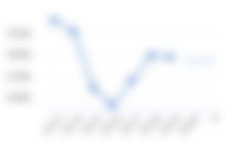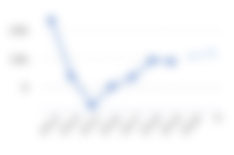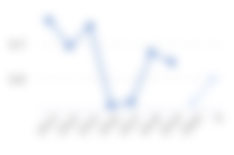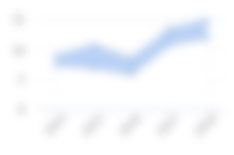WBC — Westpac Banking Share Price
- AU$114.96bn
- AU$273.25bn
- AU$21.93bn
- 40
- 67
- 71
- 63
Growth & Value
| 12m Forecast Rolling | Industry | Market | |
|---|---|---|---|
| PE Ratio (f) | 17.17 | ||
| PEG Ratio (f) | 94.12 | ||
| EPS Growth (f) | 0.18% | ||
| Dividend Yield (f) | 4.55% | ||
| Valuation (ttm) | Industry | Market | |
|---|---|---|---|
| Price to Book Value | 1.6 | ||
| Price to Tang. Book | 1.87 | ||
| Price to Free Cashflow | n/a | ||
| Price to Sales | 5.19 | ||
| EV to EBITDA | 403.03 | ||
Shareholder Activity
| Type | Buy / Hold / Sell |
|---|---|
| Institutions | |
| Directors | |
| Community |
Guru Screens
Quality
| Name | Industry | Market | |
|---|---|---|---|
| Return on Capital | 0.92% | ||
| Return on Equity | 9.63% | ||
| Operating Margin | 45.72% | ||
Financial Summary
| Year End 30th Sep | Unit | 2020 | 2021 | 2022 | 2023 | 2024 | 2025E | 2026E | CAGR / Avg |
|---|---|---|---|---|---|---|---|---|---|
| Total Revenue | AU$m | 20,391 | 21,450 | 19,875 | 21,997 | 21,932 | 22,034.76 | 22,549.37 | 0.92% |
| Operating Profit | m | ||||||||
| Net Profit | m | ||||||||
| EPS Reported | |||||||||
| Diluted Normalised EPS | |||||||||
| EPS Growth | % | -14.07 | -1.75 | -7.44 | +0.55 | -0.75 | +0.11 | +0.2 | n/a |
| PE Ratio | x | ||||||||
| PEG | |||||||||
| Profitability | |||||||||
| Operating Margin | % | ||||||||
| ROA | % | ||||||||
| ROCE | % | ||||||||
| ROE | % | ||||||||
| Cashflow | |||||||||
| Op. Cashflow ps | |||||||||
| Capex ps | |||||||||
| Free Cashflow ps | |||||||||
| Dividends | |||||||||
| Dividend ps | |||||||||
| Dividend Growth | % | ||||||||
| Dividend Yield | % | ||||||||
| Dividend Cover | x | ||||||||
| Balance Sheet | |||||||||
| Cash etc | m | ||||||||
| Working Capital | m | ||||||||
| NFA | m | ||||||||
| Net Debt | m | ||||||||
| Book Value | m | ||||||||
| Diluted Weighted Average Shares | m | ||||||||
| Book Value ps | |||||||||
Other Ratios
| Leverage (ttm) | Total | - Intang | + Pension |
|---|---|---|---|
| Gross Gearing | |||
| Net Gearing | |||
| Cash / Assets |
| Liquidity (ttm) | |
|---|---|
| Curr. Ratio | |
| Quick Ratio | |
| Interest Cov. | |
| Efficiency (ttm) | |
|---|---|
| Asset Turnover | |
| Recs Turnover | |
| Stock Turnover | |
Recent History
| Latest interim period vs. prior period | Industry | Market | |
|---|---|---|---|
| Sales Growth | |||
| EPS Growth | |||
| 3yr Compound Annual Growth Rate | Industry | Market | |
|---|---|---|---|
| Sales CAGR | |||
| EPS CAGR | |||
| DPS CAGR | |||
Profile Summary
Westpac Banking Corporation is an Australia-based company that provides banking and selected financial services, operating under multiple brands, and predominantly in Australia and New Zealand, with a small presence in Europe, North America, Asia and the Pacific. Its segments include Consumer, Business & Wealth, Westpac Institutional Bank (WIB), Westpac New Zealand and Group Businesses. The Consumer segment provides a full range of banking products and services to customers in Australia through three lines of business consisting of mortgages, consumer finance and cash and transactional banking. The Business & Wealth segment comprises business banking, wealth management, private wealth, and Westpac Pacific. The WIB segment delivers a range of financial products and services to corporate, institutional and government customers. The Westpac New Zealand segment provides banking, and wealth products and services for consumer, business and institutional customers in New Zealand.
Directors
- John Mcfarlane NEC (74)
- Peter King CEO (51)
- Michael Rowland CFO (60)
- Chris De Bruin CEX (58)
- Catherine Mcgrath CEX
- Anthony Miller CEX (51)
- Jason Yetton CEX (50)
- Scott Collary COO (57)
- David Stephen CRO (57)
- Christine Parker DHR (61)
- Carolyn McCann OTH (49)
- Leslie Vance OTH (51)
- Tim Hartin SEC (46)
- Nerida Caesar NID (57)
- Audette Exel NID (58)
- Michael Hawker NID (62)
- Christopher Lynch NID (68)
- Peter Marriott NID (64)
- Peter Nash NID (59)
- Nora Scheinkestel NID (61)
- Margaret Seale NID (61)
- Last Annual
- September 30th, 2024
- Last Interim
- March 31st, 2025
- Incorporated
- August 23rd, 2002
- Public Since
- July 18th, 1970
- No. of Shareholders
- 585,176
- No. of Employees
- 34,168
- Sector
- Banking Services
- Industry
- Financials
- Exchange
Australian Stock Exchange - SEATS
- Shares in Issue
- 3,418,386,901

- Address
- 275 Kent Street, SYDNEY, 2000
- Web
- https://www.westpac.com.au/
- Phone
- +61 291557700
- Contact
- Justin Mccarthy
- Auditors
- PricewaterhouseCoopers
Latest News for WBC
Upcoming Events for WBC
Q3 2025 Westpac Banking Corp Earnings Release
Dividend For WBCPM.AX - 1.1934 AUD
Dividend For WBCPK.AX - 1.1581 AUD
Dividend For WBCPJ.AX - 1.2463 AUD
Dividend For WBCPL.AX - 1.2463 AUD
Dividend For WBCPH.AX - 1.2110 AUD
Full Year 2025 Westpac Banking Corp Earnings Release
Westpac Banking Corp Annual Shareholders Meeting
Similar to WBC
ANZ group
Australian Stock Exchange - SEATS
Australian Finance
Australian Stock Exchange - SEATS
Bank of Queensland
Australian Stock Exchange - SEATS
Bendigo And Adelaide Bank
Australian Stock Exchange - SEATS
BNK Banking
Australian Stock Exchange - SEATS
FAQ
As of Today at 15:06 UTC, shares in Westpac Banking are trading at AU$33.63. This share price information is delayed by 15 minutes.
Shares in Westpac Banking last closed at AU$33.63 and the price had moved by +22.96% over the past 365 days. In terms of relative price strength the Westpac Banking share price has outperformed the ASX All Ordinaries Index by +12.35% over the past year.
The overall consensus recommendation for Westpac Banking is Sell. You can view the full broker recommendation list by unlocking its StockReport.
Find out moreThe Westpac Banking dividend yield is 4.52% based on the trailing twelve month period.
Last year, Westpac Banking paid a total dividend of AU$1.52, and it currently has a trailing dividend yield of 4.52%. We do not have any data on when Westpac Banking is to next pay dividends.
We do not have data on when Westpac Banking is to next pay dividends. The historic dividend yield on Westpac Banking shares is currently 4.52%.
To buy shares in Westpac Banking you'll need a share-dealing account with an online or offline stock broker. Once you have opened your account and transferred funds into it, you'll be able to search and select shares to buy and sell. You can use Stockopedia’s share research software to help you find the the kinds of shares that suit your investment strategy and objectives.
As of the previous close price of AU$33.63, shares in Westpac Banking had a market capitalisation of AU$114.96bn.
Here are the trading details for Westpac Banking:
- Country of listing: Australia
- Exchange: ASX
- Ticker Symbol: WBC
Based on an overall assessment of its quality, value and momentum Westpac Banking is currently classified as a Turnaround. The classification is based on a composite score that examines a wide range of fundamental and technical measures. Stock are classified on the the following spectrum: Super Stocks, High Flyers, Contrarians, Turnarounds, Neutral, Value Traps, Momentum Traps, Falling Stars, and Sucker Stocks. For more information, learn about our StockRank Styles.
The analyst consensus target price for shares in Westpac Banking is AU$28.60. That is 14.97% below the last closing price of AU$33.63.
Analysts covering Westpac Banking currently have a consensus Earnings Per Share (EPS) forecast of AU$1.96 for the next financial year.
Find out moreAn important predictor of whether a stock price will go up is its track record of momentum. Price trends tend to persist, so it's worth looking at them when it comes to a share like Westpac Banking. Over the past six months, its share price has underperformed the ASX All Ordinaries Index by -0.76%.
As of the last closing price of AU$33.63, shares in Westpac Banking were trading +4.36% higher than their 200 day moving average. You can read more about the power of momentum in assessing share price movements on Stockopedia.
The Westpac Banking PE ratio based on its reported earnings over the past 12 months is 17.17. The shares last closed at AU$33.63.
The PE ratio (or price-to-earnings ratio) is the one of the most popular valuation measures used by stock market investors. It is calculated by dividing a company's price per share by its earnings per share.
The PE ratio can be seen as being expressed in years, in the sense that it shows the number of years of earnings which would be required to pay back the purchase price, ignoring inflation. So in general terms, the higher the PE, the more expensive the stock is.
Westpac Banking's management team is headed by:
- John Mcfarlane - NEC
- Peter King - CEO
- Michael Rowland - CFO
- Chris De Bruin - CEX
- Catherine Mcgrath - CEX
- Anthony Miller - CEX
- Jason Yetton - CEX
- Scott Collary - COO
- David Stephen - CRO
- Christine Parker - DHR
- Carolyn McCann - OTH
- Leslie Vance - OTH
- Tim Hartin - SEC
- Nerida Caesar - NID
- Audette Exel - NID
- Michael Hawker - NID
- Christopher Lynch - NID
- Peter Marriott - NID
- Peter Nash - NID
- Nora Scheinkestel - NID
- Margaret Seale - NID





